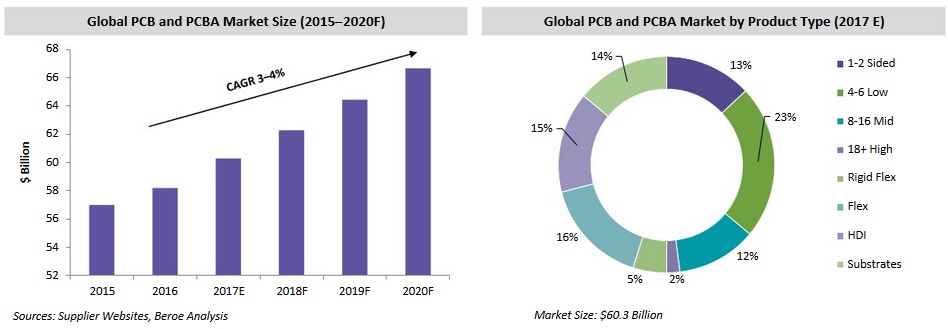Negosentro|Printed Circuit Board Market Size, Industry Analysis And Opportunities|In today’s world, it is hard to imagine our days without our gadgets. Be it our mobile phones or PCs, automobiles or everyday home appliances, the idea of “smart” electronics has become intricately woven into our lifestyles. With the embedment of cutting edge technology in almost every category of electronics, the landscape of the electronics industry has changed drastically. The ever-evolving ecosystem of electronics is hinged on the printed circuit boards (PCB), often, and aptly referred to as the “motherboard”. PCB essentially is the fiberglass plate with copper traces on which the circuit design and other components of the electrical apparatus are mounted. So, while new inventions continue to create tectonic shifts in the market practices and consumption patterns, the relevance and demand for PCBs are not likely to dwindle.
The printed circuit board market size has recorded steady growth in recent years. This is primarily fuelled by the co-adoption of the PCBs in the vehicle industry and the development of compact PCBs for the circuit design of sleeker electronic appliances. Globally, especially in developing economies, the PCB value chain is boosted by the enhanced government interest in digitization. Consequently, the printed circuit board market size not only looks promising but is also rapidly expanding.
Printed Circuit Board Market: Industry Statistics

- The Global PCB market size is currently estimated at $60.2 billion.
- The projected global compound annual growth rate (CAGR) of the PCB market is 4.3% between 2019 and 2024.
- The APAC region is a major player in the production of PCBs, contributing to 90% of the overall production.
- The demand for PCBs is fuelled by the widespread digitization and innovative use of technology in different industries in the Asia-Pacific countries. In the last five years, India has emerged as one of the most vital stakeholders in the PCB industry.
- The end-use sectors in countries like China, Taiwan, South Korea, Japan have been the bedrock behind the rise in demand of the printed circuit board markets. This is mostly due to the presence of electronic giants such as Samsung, Sony, Panasonic, among others, in this region. Market reports hint at an emerging value chain from enterprises based in Singapore, Thailand, and Vietnam. This is expected to bolster the overall demand for PCBs globally.
Printed Circuit Boards Market: Industry Analysis
PCBs are an indispensable substrate for all gadgets. Therefore, all-pervasive digitization, the rapid expansion of the communications sector, and the compliance to eco-friendly laws and regulations make it indispensable for every stakeholder in the electronics industry to invest in PCBs.
- Consumer electronics, telecom services, automotive, computer hardware, industrial electronics, and even LED lighting are sectors which foster a bludgeoning demand for PCBs, driven by the high demand for their products in the consumer markets. If this is analyzed in the context of low manufacturing costs of most Asia-Pacific countries, then going by simple economies of scale, the PCB market in APAC is not only promising but also incredibly sustainable.
- This is, however, not to say that the demand for PCB is lacking in other regions of the world. The PCB bookings in North America have risen significantly in 2018-19. The adoption of the PCBs in the vehicle industry plays a dominant role in this phenomenon.
In light of the diversified usage, complemented by large-scale manufacturing operations worldwide, the PCB industry is expected to accelerate substantially. Between 2017 and 2021, the printed circuit board market size is expected to rise by $20.4 billion, globally.
Printed Circuit Board Market Insights and Opportunities
Given that PCBs are integral to a gamut of products in the electronics industry, a promising scope of growth may safely be forecast.
Market Drivers:
Firstly, access to digitized gadgets has increased rampantly in the past decade. It has permeated different geo-political and socio-economic geographies. There are currently 4.39 billion internet users across the world. The changing consumption patterns and volumes have triggered off a heightened demand for PCBs. While APAC is the primary region for the supply of PCBs, it has also played a key role in the demand over the last decade, further supported by local governments. For example, the government of India’s “Make in India,” and “Digital India” initiatives that aim to expand the scope of digitization in the everyday lives of an average Indian citizen.
Secondly, PCBs are crucial to support environment-friendly innovations in technology. With increased government emphasis on sustainability, the opportunities for market expansion of PCBs have significantly enhanced.
Further, innovations in the design of PCBs helped in widening its usage. The need for different computer peripherals and electronic devices to meet the fuel emission standards for the automotive industry and the demand for cost-efficient alternatives to traditional epoxy are all catered to by the compact, miniaturized design of PCBs. Consequently, more and more industries are enabling enhanced market opportunities for PCBs.
Market Constraints
However, one factor that can potentially dampen the growth rates of PCBs is the increasing labor and utility cost of the production of PCBs. These costs account for 60-85 percent of the total production cost and in absolute terms can slow down the growth rate of the printed circuit board markets.
Conclusion
Today, the world is mired in less than six degrees of separation, and the development of the communications and automotive industries has played a huge role in it. The advanced technology that characterizes PCBs is at the heart of such development. Thus, going by the market trends and industry insights, it won’t be far fetched to say that PCBs are not only here to stay but will go a long way in shaping our future.
Source














